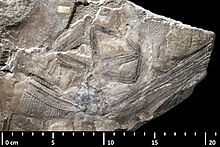| Meganeura Temporal range: Kasimovian-Gzhelian,
| |
|---|---|

| |
| M. monyi specimen MNHN R52938 which was originally attributed to different genus Meganeurella | |

| |
| M. monyi specimen LdLAP 392 | |
| Scientific classification | |
| Domain: | Eukaryota |
| Kingdom: | Animalia |
| Phylum: | Arthropoda |
| Class: | Insecta |
| Division: | Palaeoptera |
| Superorder: | Odonatoptera |
| Order: | †Meganisoptera |
| Family: | †Meganeuridae |
| Genus: | †Meganeura Brongniart, 1885 |
| Species | |
| |
Meganeura is a genus of extinct insects from the Late Carboniferous (approximately 300 million years ago). It is a member of the extinct order Meganisoptera, which are closely related to and resemble dragonflies and damselflies (with dragonflies, damselflies and meganisopterans being part of the broader group Odonatoptera). Like other odonoapterans, they were predatory, with their diet mainly consisting of other insects. The genus belongs to the Meganeuridae, a family including other similarly giant dragonfly-like insects ranging from the Late Carboniferous to Middle Permian. With single wing length reaching 32 centimetres (13 in)[1] and a wingspan about 65–75 cm (2.13–2.46 ft),[2][3][4] M. monyi is one of the largest-known flying insect species.

Fossils of Meganeura were first discovered in Late Carboniferous (Stephanian) Coal Measures of Commentry, France in 1880. In 1885, French paleontologist Charles Brongniart described and named the fossil "Meganeura" (great-nerved), which refers to the network of veins on the insect's wings. Another fine fossil specimen was found in 1979 at Bolsover in Derbyshire. The holotype is housed in the National Museum of Natural History, in Paris. Despite being the iconic "giant dragonfly", fossils of Meganeura are poorly preserved in comparison to other meganeurids.[5]
- ^ Nel et al. 2008.
- ^ Rake 2017, p. 20.
- ^ Taylor & Lewis 2007, p. 160.
- ^ Manzanera, R.A.J.; Smith, H. (2015). "Flight in nature I: Take-off in animal flyers". The Aeronautical Journal. 119 (1213): 257–280. doi:10.1017/S0001924000010472.
- ^ Nel, André; Prokop, Jakub; Pecharová, Martina; Engel, Michael S.; Garrouste, Romain (2018-08-14). "Palaeozoic giant dragonflies were hawker predators". Scientific Reports. 8 (1): 12141. Bibcode:2018NatSR...812141N. doi:10.1038/s41598-018-30629-w. ISSN 2045-2322. PMC 6092361. PMID 30108284.